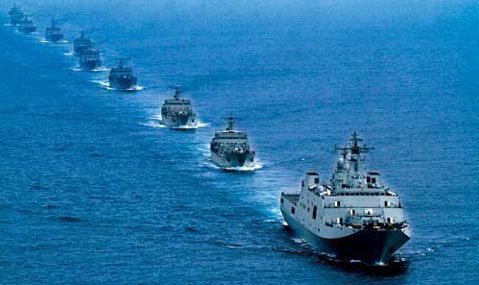
From fishing boats…
In the early April, the smoldering dispute in the East Sea broke out into a clash between China and the Philippines at Scarborough Shoal. Manila accused Chinese fishermen of illegally infiltrating and fishing in its waters, which is recognized by the international law. Filipino naval ships managed to catch these fishermen but China sent two marine patrol ships to the area of conflict.
China sent many more vessels to the shoal to confirm its presence in the form of overwhelming in majority. The Philippines detected nearly 100 Chinese ships around and inside the shoal, ignoring the fishing ban in this area.
The two sides decided to withdraw their ships from the shoal, reasoning bad weather. While the Philippines pulled out all of its ships in the shoal, up to 30 Chinese boats were reported to be there, according to a Filipino security official on July 19. The anonymous official said that there were signs that Chinese boats caught fish in the exclusive economic zone (EEZ) of the Philippines.
Both sides claim their sovereignty over Scarborough Shoal. China still cites historical evidences to prove its sovereignty over the shoal, the same way it does with other disputes in the East Sea.
Manila said that the shoal is within its EEZ, which is recognized by the United Nations Convention on the Law of the Sea 1982 (UNCLOS). The shoal is over 230km from this country’s Luzon Island and over 1,200km from China.
If the UNCLOS is used to settle the dispute, China ran out of arguments. Therefore, China denies the value of this convention in solving the dispute, though it joined the convention.
… to war ships
After the clash at the Scarborough shoal, another incident happened at a site which is nearer to the Philippines than Scarborough. A Chinese missile frigate, which was reported by the Chinese media to be on a patrol, was stuck at a shoal that is only 110km from Palawan province of the Philippines. China organized a noisy rescue campaign. The war ship was rescued and returned to China, leaving behind many questions.
Naval officials of the Philippines said this vessel harassed and threatened some Filipino fishing boats last year.
Rory Medcalf, director of the international security program at the Lowy Institute, said that it was alarming that the Chinese were now using naval vessels to patrol the disputed area.
“Does that mean sooner or later we will see confrontational incidents involving naval vessels rather than civilian agencies,” he said on the Philstar.
It is a big question to why China sent a warship of a thousand tons to a hollow and dangerous sea at night, where even fishing boats run very carefully in the day time.
It is understood that China is trying to threaten others and drive them away from an area where China does not make legal claims, but wants to seize.
This is China’s traditional strategy, called “bleeding to death or death of a thousand cuts.” By constantly applying a little pressure on its rivals in the East Sea dispute, China weakens the opposition.
And establishing a city
More rudely, in late June, China approved the establishment of the so-called Sansha City to manage three groups of islands in the East Sea and their surrounding waters.
From constantly applying a little pressure on its rivals in the East Sea dispute, China now set up a city, which has administrative machinery and is accompanied with military force to “protect” the administration amid international waters.
The Philippines and Vietnam raised objections but China keeps building the so-called Sansha city. On July 20, China approved the establishment of a military unit that stations in Sansha. Marine management activities have also been implemented.
The China National Radio has reported that more than 1,100 Chinese voters in 15 constituencies on the Tay Sa, Nam Sa and Trung Sa islands cast ballots on July 21 to elect deputies to their so-called Sansha city municipal people’s council.
These islands belong to Vietnam’s Hoang Sa (Paracel) and Truong Sa (Spratly) archipelagos, and the act seriously violates Vietnam’s sovereignty over the cluster of islands.
After making the statement of the so-called Sansha city, China sent a fleet of 30 fishing ships to Truong Sa Islands, escorted by its largest fishery administration vessel No. 310.
To support the government’s acts, a propaganda campaign about the so-called China’s sovereignty in the East Sea has been launched. A leading Chinese fishery official has urged Beijing to provide arms and military training for 100,000 fishermen and let them roam the East Sea to defeat countries in the region challenging China’s sweeping claims of sovereignty in those waters.
The Global Times of China recently launched a discussion entitled “If you were the mayor of Sansha, what would you do?” This newspaper emphasized: “On July 17, China set up an organizing committee for the legislative body of Sansha, officially beginning the formation of the government of the newly established city in the South China Sea. As the biggest prefecture-level city in China, Sansha has a unique geography and extraordinary strategic location. Consequently, it needs totally different management methods from other cities."
In 2002, China and the Association of Southeast Asian Nations (ASEAN) signed the Declaration on the Conduct of Parties in the East Sea (DOC) to solve disputes peacefully. Ten years after that agreement was signed, China wants to change it and it is trying to occupy the entire East Sea.
Thai An